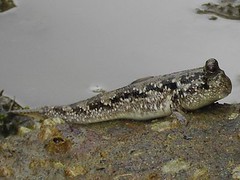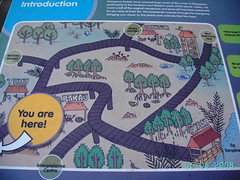People present: Airani, Siva, Edward and me
After meeting at 8am at the Lim Chu Kang jetty, we walked past the rubbish-strewn coast at the front of the mud lobster mounds and headed in to the mangrove.
This mangrove is supposedly in its pristine conditions as little or nothing is man-made or artificially planted. The mud lobster mounds were big and numerous, supporting a healthy population there, I suppose. Afterwhich, we followed a stream, which opened into the sea, and headed into the mangrove forest. As compared to Sungei Buloh which is just “next door”, I am surprised by the canopy cover of Lim Chu Kang. The root system of the area has almost filled up the entire area except for the stream banks.
The burrows of larger sizes were found only next to the stream if there is a patch of area not covered by the pneumatophores. The smaller mudskippers were more readily seen and associated with the stream line while I really scratch my head about where are the bigger ones?
Since the giant mudskipper is a obligate aerobes, it would not be found in the burrows at low tide. All opportunities to stay emerged will be made use of. Are they out feeding when the tide goes out? If so, where? How come they appear at the openings of the burrow when the tide comes in? Are the burrows connected to the sea?
Then there was this 10-15cm thing that was right under our nose which I cannot identify cos the next movement caused it to jump into its burrow. I think it is a B. boddarti.
As tide rises, movement is seen at some burrows along the stream. The bigger size ones just popped back into the burrows as we go any nearer; there was a "school" of smaller ones which started appearing on the banks of the stream and were not affected by us as much.
As me and Edward were leaving the area, we went to the jetty to wash up. There we found a small number of small muskippers at the floating barrels. They were feeding on the barnacles on the barrels and we put one into the bottle since we are not sure what it is.
I learnt that on the mud, the mudskippers measure danger (us) more effectively than the ones we saw at Sungei Buloh when we were on the boardwalk.

